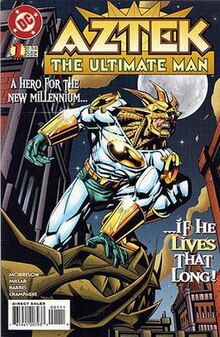
Orion is a fictional superhero appearing in comic books published by DC Comics. He is the son of Darkseid and half-brother of Kalibak and Grayven who was traded to Highfather as part of a peace deal between Apokolips and New Genesis. Since then, Orion has assisted the New Gods of New Genesis against his father and was also a member of the Justice League.
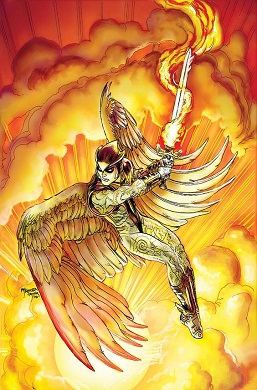
Zauriel is a fictional superhero in the DC Universe. Originally a guardian angel who served Heaven for millions of years, he willingly falls to Earth to serve humanity as their champion and joins the Justice League.

Imperiex is a supervillain appearing in comic books published by DC Comics. He was initially introduced as an adversary to the superhero Superman, before becoming a main antagonist for the crossover "Our Worlds at War".

The Black Racer is a fictional character, a deity and avatar of Death in the DC Comics universe who often hunts those affiliated with the New Gods. The character first appears in New Gods #3 and was created by Jack Kirby.
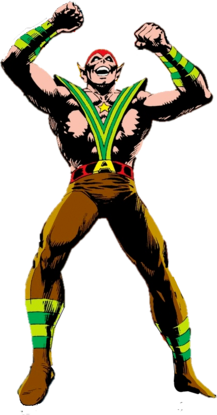
Amazo is a supervillain appearing in American comic books published by DC Comics. The character was created by Gardner Fox and Mike Sekowsky and first appeared in The Brave and the Bold #30 as an adversary of the Justice League of America. Since debuting during the Silver Age of Comic Books, the character has appeared in comic books and other DC Comics-related products, including animated television series, trading cards and video games. Traditionally, Amazo is an android created by the villain scientist Professor Ivo and gifted with technology that allows him to mimic the abilities and powers of superheroes he fights, as well as make copies of their weapons. His default powers are often those of Flash, Aquaman, Martian Manhunter, Wonder Woman, and Green Lantern. He is similar and often compared with the later created Marvel android villain Super-Adaptoid.
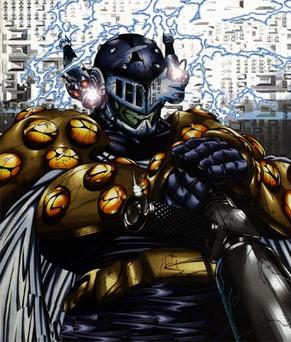
Prometheus is a name used by multiple supervillains appearing in comic books published by DC Comics. Created by writer Grant Morrison and penciller Arnie Jorgensen, the most recognized version first appeared in New Year's Evil: Prometheus. Commonly an adversary of the Justice League and a villainous foil personality to Batman, Prometheus would serve as an enemy to superheroes including Batman, Green Arrow and Midnighter.

Big Barda is an antihero appearing in American comic books published by DC Comics. She first appeared in Mister Miracle #4, and was created by Jack Kirby. She was raised as a member of the New Gods, but left to become a hero.
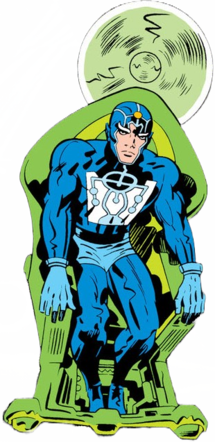
Metron is a fictional antihero appearing in American comic books published by DC Comics.
The International Ultramarine Corps, formerly the Ultramarine Corps, is a fictional team of superheroes published by DC Comics. They first appeared in DC One Million #2, and were created by Grant Morrison and Howard Porter.
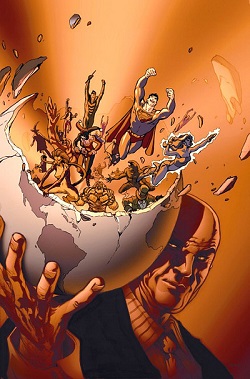
Secret Society of Super Villains (SSoSV) is a DC Comics title that debuted in May–June 1976. The series presented a group of DC's supervillains, mostly foes of the Justice League of America. The series was cancelled with issue #15 in July 1978, as part of the DC Implosion, a period when DC suddenly cancelled dozens of comics.

Shaggy Man is the name of several fictional characters appearing in comic books published by DC Comics.

Mantis is a fictional supervillain appearing in comic books published by DC Comics, part of Jack Kirby's New Gods series.

Bulleteer is a fictional character and DC Comics superheroine, a member of the Seven Soldiers. She debuted in Seven Soldiers: The Bulleteer #1, and was created by Grant Morrison and Yanick Paquette. The character is based in part on the Fawcett Comics character Bulletgirl.
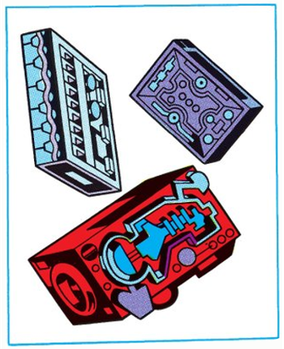
Mother Boxes are fictional devices in Jack Kirby's Fourth World setting in the DC Universe.

Batman Total Justice is a line of toys produced by Kenner based on Batman and other, connected, DC Comics characters.
Virman Vundabar is a fictional extraterrestrial supervillain published by DC Comics.

Kanto is a supervillain and extraterrestrial assassin published by DC Comics.

Tezcatlipoca is a name used by two distinct fictional characters appearing as supervillains in DC Comics publications and related media.

JLA was a monthly comic book published by DC Comics from January 1997 to April 2006 featuring the Justice League of America. The series restarted DC's approach to the Justice League, which had initially featured most of the company's top-tier superheroes but shifted in the 1980s to featuring a rotating cast of established characters alongside newer ones and also saw that franchise expand to several spin-off series, diluting the prestige of the name brand. When relaunched by writer Grant Morrison, the team again focused on the most recognizable, powerful, and long-lasting heroes in DC's library.
Shining Knight is the name of multiple fictional superheroes appearing in American comic books published by DC Comics. The original version was created by Creig Flessel and first appeared in Adventure Comics #66.
